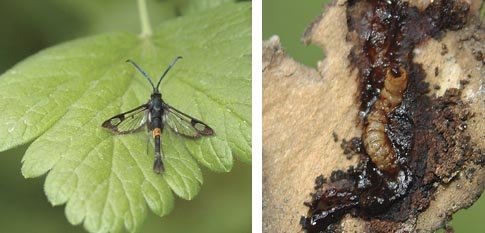
Although control measures have been reasonably effective in the fight against the apple clearwing moth in British Columbia, Canada’s Similkameen Valley, the insect is proving to be alarmingly pervasive.
Following North America’s first confirmed discovery of the clearwing moth (Synanthedon myopaeformis) in B.C.’s southern interior in 2005, it has since been identified in orchards in Keremeos, Oliver, North Osoyoos, Kelowna and coastal B.C., as well as in Ontario and parts of Washington State.
The moths lay eggs in burr knots, pruning scars, grafts, and bark wounds of apple trees, then their larvae bore under the bark anywhere from below the crown area up to branches. Larvae feed on the cambium layer of trees for almost two years before pupation, and can kill young trees.
In the drier desert climate of B.C.’s southern interior, infested trees are prone to drought stress, which can contribute to tree deaths. In highly infested orchards, damage can also spread to tree canopies.
Linda Edwards, a pest management consultant whose own orchard in Cawston, B.C., is infested, said that a 2008 survey showed that in the bench area of the Similkameen Valley, where most of the orchards are located, there was 95 to 100 percent infestation by the moth.
She is convinced that the insect was introduced to the area about ten years ago from Malling 9 rootstock imported from the Netherlands, where, because of the cooler climate, the pest isn’t as prevalent.
“We didn’t have M.9 rootstock when we started replanting,” she said. “We brought it in from Holland. We can even sort of figure out which nurseries probably had it.”
Surveys of clearwing infestation in the Similkameen appear to confirm her suspicions.
“We surveyed every orchard from the [Canada/U.S.] border to the other side of Keremeos [in 2008],” Edwards said. “There were a couple of orchards by the border—people who had gotten their rootstock from the United States or had grown their own trees—and they didn’t have any [infestation]. Then the next orchard had 17 percent and the next orchard after that a few miles down had 33 percent, and it wasn’t a replant orchard. When you hit the bench, it went to 95 and 100 percent. As you move to some of the more traditional orchards, it dropped off. It spread from where most of the replant was done most intensely. It’s now in standard rootstock trees and big old trees have it as well.”
Joe Sardinha, president of the B.C. Fruit Growers’ Association, said the moth can turn into a very serious matter, but if growers take the initiative and do some cleanup, the industry can prevent its further spread and take control of it as well. He added that the association contributed $10,000 to help offset the cost to Similkameen growers for, among other things, an employee who did orchard surveys and analyzed how their product treatments were working.
“Even though it [the infestation] is mostly confined to that area, we felt it was something we wanted to put some money into,” Sardinha said. “Being an industrywide issue, it was a question of fairness. Why should one group be expending all these resources on something that has the ability to impact the entire industry?”
Control tactics
Similkameen growers have had success the past two years controlling the insect using trunk applications of Entrust (spinosad) in both organic and conventional orchards. Although pheromone mating disruption using Isomate-P dispensers proved to be futile, researchers at the Pacific Agri-Food Research Centre in Summerland, B.C., are investigating new pheromone blends. Nematode trials and screening trials for other pesticides are also being conducted.
The B.C. Ministry of Agriculture and Lands Web site suggests reducing the risk of infestations by minimizing wounds to trees, removing young trees with cankers, and sealing wounds with wound-protecting products. Wrapping the base of trees with polyester batting (a pillow stuffing product) will discourage egg laying and prevent escape of emerging adults.
Mass trapping using two-liter plastic bottle traps baited with grape juice and painted yellow has been shown to be highly attractive to both male and female clearwing moths.
Edwards said Entrust trunk sprays reduced the larvae levels from as many as 20 per tree to fewer than one, but weekly spraying with guns during the moth flight season (early June to late August) was costly and labor intensive. Retired farm equipment manufacturer Bill Bleasdale designed a sprayer that uses an electronic eye to switch off the spray between trunks, and a number of orchardists used them.
Effective
“When we lumped everything together, the gun sprays are the most effective,” Edwards said. “But we still have to do one more year of research before we determine the right number of sprays and the timing.”
She said the moth is extremely active and moves in swarms from orchard to orchard.
“I’m an entomologist, and I have a lot of respect for insects,” she said. “We’ve never eradicated one, ever. Hopefully, what we’re doing here in the Similkameen will reduce the chances of the infestation spreading.
“But we know they’re in Oliver/Osoyoos, and if they’re in Oliver/Osoyoos, they can make their way north. People have to be vigilant. There’s no way we’re going to eradicate them, but I think we can learn to contain them. We just have to learn to get those populations down as economically as possible.”
—by Amanda Hollingsworth

Leave A Comment